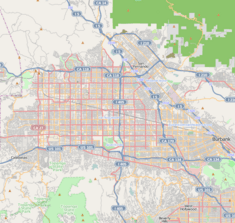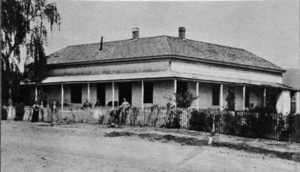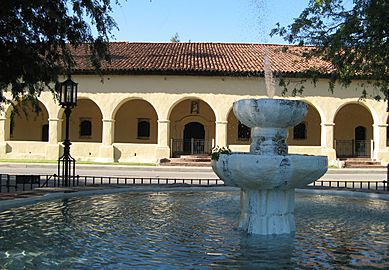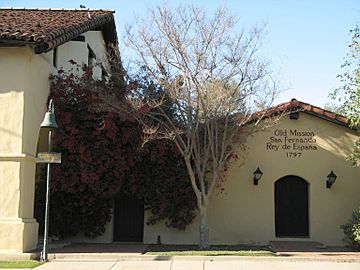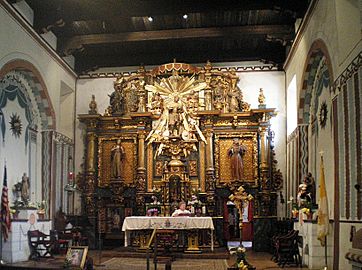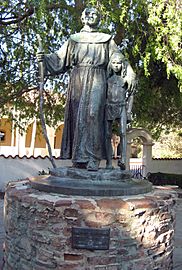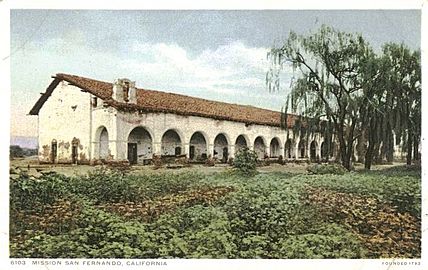Mission San Fernando Rey de España facts for kids
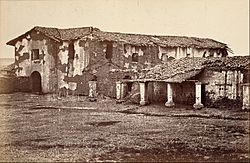
Mission San Fernando Rey de España in a dilapidated state, c. 1885
|
|
| Location | 15151 San Fernando Mission Blvd. Los Angeles, California 91345 |
|---|---|
| Coordinates | 34°16′23″N 118°27′40″W / 34.2731°N 118.4612°W |
| Name as founded | La Misión del Señor Fernando, Rey de España |
| English translation | The Mission of Saint Ferdinand, King of Spain |
| Patron | Ferdinand III of Castile |
| Nickname(s) | "Mission of the Valley" |
| Founding date | September 8, 1797 |
| Founding priest(s) | Father Fermín Lasuén |
| Founding Order | Seventeenth |
| Military district | Second |
| Native tribe(s) Spanish name(s) |
Tataviam, Tongva Fernandeño, Gabrieleño |
| Native place name(s) | 'Achooykomenga, Pasheeknga |
| Baptisms | 2,784 |
| Marriages | 827 |
| Burials | 1,983 |
| Secularized | 1834 (Rancho Ex-Mission San Fernando) |
| Returned to the Church | 1861 |
| Governing body | Roman Catholic Archdiocese of Los Angeles |
| Current use | Chapel-of-ease/Museum |
| Designated | 1971 |
| Delisted | 1974 |
| Reference no. | 71001076 |
| Designated | October 27, 1988 |
| Reference no. | 88002147 |
| Reference no. | #157 |
| Reference no. | 23 |
Mission San Fernando Rey de España is a historic Spanish mission located in Mission Hills, Los Angeles, California. It was founded on September 8, 1797, making it the seventeenth of the twenty-one Spanish missions built in Alta California. The mission is named after Saint Ferdinand, a king of Spain. It also gave its name to the nearby city of San Fernando and the large San Fernando Valley.
The mission was taken over by the government in 1834, a process called secularization. It was returned to the Catholic Church in 1861 and became a working church again in 1920. Today, the mission grounds are a museum. The church serves as a special chapel for the Archdiocese of Los Angeles.
Contents
History of the Mission
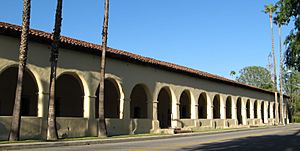
In 1769, the Spanish Portolà expedition explored inland California for the first time. They camped near where the mission would later be built. A missionary with them, Fray Juan Crespí, wrote in his diary about the beautiful location.
Founding the Mission
Mission San Fernando Rey de España was the 17th mission founded by Franciscan friars in Alta California. The land chosen for the mission was a ranch owned by Francisco Reyes. This area was already home to Ventureño Chumash, Fernandeño (Tongva), and Tataviam people who worked in farming.
Father Fermín Lasuén officially founded the mission on September 8, 1797. He held ceremonies and dedicated the mission to Saint Ferdinand, King of Spain. On that first day, ten children were baptized. By the end of the year, 55 native people, called neophytes, had joined the mission community.
The first mission church was a small adobe building. It was finished just months after the mission started. However, it quickly became too small, and a larger adobe church was built within two years.
Life at the Mission (Early 1800s)
As the mission grew, more buildings were added. Workshops, granaries, and places for making wine and candles were built. A large building with rooms for native families and single women was also constructed.
In 1804, construction began on the third and main church. This church, made of adobe with a tile roof, was blessed in December 1806. It was much larger and served the mission for many years. Around this time, about seventy adobe rooms were also built for the native people living at the mission.
The number of native people living at the mission grew from 310 in 1800 to 955 by 1809. Many baptisms took place during these years.
Challenges and Changes (1810s-1830s)
Starting in the 1810s, the missions faced difficulties. Spain was involved in wars, so less support and money came to California. The missions had to rely more on their own resources. Soldiers' wages were often unpaid, and they took supplies from the missions. This put a lot of pressure on the native workers.
An earthquake in 1812 damaged the church, requiring repairs. A large building for the friars, called the convento, was also expanded during this time. By 1819, the mission's population reached its highest point with 1,080 people. After this, the population began to decline. The difficult conditions led many native people to leave the missions.
Mexican Rule and Secularization
In 1821, Mexico gained independence from Spain. Alta California, including the missions, became part of Mexico. The missions continued to face challenges, with soldiers demanding supplies and causing problems.
In 1834, the Mexican government officially took control of the mission. This process, called secularization, meant the mission lands and buildings were no longer managed by the church. Many native people returned to their traditional lands or worked on nearby ranches for low wages.
In 1842, a small amount of gold was discovered near the mission. This was six years before the famous California Gold Rush. The area was named Placerita Canyon because of this discovery.
In 1845, the mission buildings were put up for sale by the governor. The next year, the mission became the headquarters for a private ranch. The buildings were neglected and fell into disrepair.
Modern History and Restoration
In the late 1800s, the mission buildings were used for different purposes, including a warehouse and even a hog farm. In 1861, the mission buildings and 75 acres of land were returned to the Catholic Church. However, many parts of the buildings had been taken by settlers for materials.
Restoration efforts began in the early 1900s. A significant donation from the Hearst Foundation in the 1940s helped fully restore the mission. The mission museum now holds important items from the Mexican church and part of the Doheny library.
The church was badly damaged by the 1971 San Fernando earthquake but was completely rebuilt and reopened in 1974. Today, it is well-maintained and still used as a chapel. The Convento Building was recognized as a historic landmark in 1988. Famous comedian Bob Hope and his wife Dolores are buried in the Bob Hope Memorial Gardens at the mission.
Mission Industries and Daily Life
The Spanish missions had two main goals: to spread Christianity and to create Spanish settlements. Since it was hard to get supplies from far away, the missions had to become self-sufficient. This meant they had to produce almost everything they needed.
Native people at the mission learned European farming methods and how to care for animals. They also learned skills like making candles, weaving cloth, and working with tools.
Mission San Fernando was known for its good quality wines. There were over 32,000 grapevines around the mission walls. At its busiest, the mission produced about 2,000 gallons of wine and 2,000 gallons of brandy. They also had about 70 acres of olive trees for making olive oil.
Men worked in the fields, tending to cattle, horses, and sheep. They grew crops like wheat, barley, peas, beans, corn, figs, and peaches. Women worked in weaving rooms, making cloth for the community. Sundays and holy days were set aside for rest and prayer.
Mission Bells
Bells were very important for daily life at the mission. They rang to call people to meals, to work, and to church services. Bells also signaled births, funerals, or the arrival of a ship or missionary. Newcomers learned the special ways to ring the mission bells.
An interesting discovery happened in 1920 when a 100-pound bell was found near the mission. It had a Russian inscription from 1796, saying it was cast on Kodiak Island in Alaska. No one knows for sure how this Russian Orthodox bell ended up at a Catholic mission in Southern California!
Gallery
-
A statue of Saint Father Junípero Serra and a native child at Mission San Fernando
See also
 In Spanish: Misión San Fernando Rey de España para niños
In Spanish: Misión San Fernando Rey de España para niños
- Convento Building (Mission San Fernando)
- List of Spanish missions in California
- List of Los Angeles Historic-Cultural Monuments in the San Fernando Valley
- Rancho Ex-Mission San Fernando
- San Fernando Mission Cemetery
- Spanish missions in California
- USNS Mission San Fernando (AO-122) – a ship named after the mission
- Casa De San Pedro served mission in past
- Chatsworth Calera owned by mission in past


